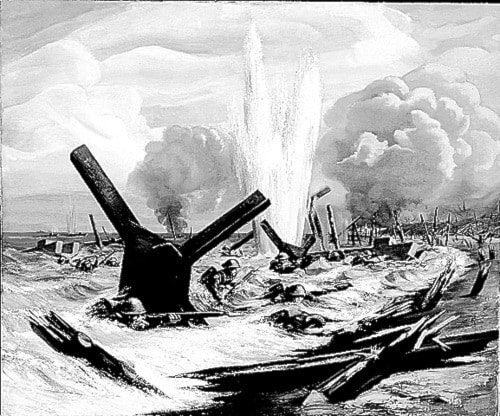Orville Fisher’s paintings of the Second World War constitute one of the most complete records of Canada’s day-to-day role in that conflict.
Perhaps his chief claim to fame is that he was the only Allied war artist to land in Normandy on D-Day, June 6, 1944.
Attached to the 3rd Canadian Infantry Division, Fisher landed on Juno Beach at Courseulles-sur-Mer.
The Germans had tipped the beach obstacles, used for cover by Canadian soldiers, with explosives to destroy landing craft and stop advancing tanks.
In preparation for the D-Day invasion, he strapped tiny waterproof pads of paper to his wrist.
After racing up the beach from his landing craft, Fisher made rapid, on-the-spot sketches, using perfectly dry materials, of the battle unfolding around him. Later, the artist created larger watercolour paintings away from the battlefront.
Unlike fellow war artist Charles Comfort’s reconstruction of the August 1942 Dieppe Raid that was created four years after the event in the peace and security of a studio, Fisher’s D-Day – The Assault was based on a real-life experience of action replete with all the turmoil and blood.
In a 1964 interview, Fisher described landing in France on D-Day: “The noise was unbearable, even off-shore. The big battle wagons, cruisers, destroyers and rocket ships were all throwing shells at the coast. The din was terrific. The coast was a neutral landscape – greys and khaki and dark browns when the khaki uniforms got wet. The only bright colors on the beach were the flags showing where each unit was to land ... The water was literally red with blood. It ebbed and flowed with the tide ... I had a three-inch square water-color pack and a hand-sized sketch pad –with waterproof paper – that had a strap fitted over my palm. I used glycerin with water colors to make a fast series of sketches, like shorthand notes.”
Fisher worked as a service artist with the Canadian Army beginning in February 1942, and a year later became an official war artist. He did not re-enter civilian life until July 1946.
